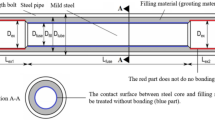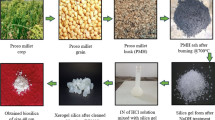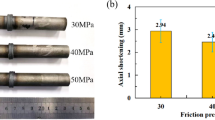Abstract
This paper examined bending fatigue strength of shot-peened spring steel under the high cycle fatigue (HCF) and very high cycle fatigue (VHCF), and analyzed the effects of shot-peening on the high strength spring steel through service life. Hourglass shape specimens made of spring steel (Si-Cr alloys) were prepared for the rotary bending fatigue test. Actual local stresses were quantitatively calculated to compensate for the applied stress amplitudes, through which it was clarified that the shot-peening had strongly positive effects on the HCF strength, but rather negative effect on the VHCF strength. The fracturing process examination confirmed that most fish-eye fractures arose at sites deeper than the compressive residual stress zone, which did not prevent the creation of the fish-eye. The fatigue strength improvement in the VHCF range was scarcely expected as a result of the shot-peening treatment.
Similar content being viewed by others
Abbreviations
- R:
-
Stress ratio
- σ :
-
Nominal stress of the gauge portion
- M:
-
The maximum bending moment
- c:
-
Distance from the neutral axis to a designated height
- I:
-
Geometrical moment of inertia at the gage part
- α:
-
Stress concentration factor
- P:
-
Load
- m:
-
Fixed test span
- d:
-
Gage part cross-section diameter
- Ra :
-
Average roughness
- Rq :
-
Root mean square
- Ktn :
-
Stress concentration factor
- σ0 :
-
Nominal stress
- σa :
-
Stress amplitude
- Nf :
-
Number of fatigue test cycles
- A:
-
Y-intercept that indicates the initial fatigue strength
- B:
-
Decreasing slope of fatigue strength as the life cycle increases
- σf :
-
Fatigue limit
- σu :
-
Tensile strength
- σf0 :
-
Fatigue limit of unpeened uniaxial specimen
- σu0 :
-
Tensile strength of unpeened uniaxial specimen
- σm :
-
Mean stress
- σrd :
-
The maximum residual stress
- R2 :
-
Regression coefficient
- SSR:
-
Residual sum of squares
- SST:
-
Total sum of squares
- σA :
-
Actual stress
- σL :
-
Local stress
- Df :
-
Diameter of fish-eye
References
B. Pyttel, D. Schwerdt and C. Berger, Very high cycle fatigue — is there a fatigue limit?, International Journal of Fatigue, 33 (2011) 49–58.
K. Shiozawa and L. Lu, Very high cycle fatigue behavior of shot-peened high carbon chromium bearing steel, Fatigue and Fracture of Engineering Materials & Structures, 25(8–9) (2002) 813–822.
Y. Furuya, T. Abe and S. Matsuoka, 1010-cycle fatigue properties of 1800 MPa-class JIS-SUP7 spring steel, Fatigue and Fracture of Engineering Materials & Structures, 26 (2003) 641–645.
T. Sakai, A. Nakagawa, N. Oguma, Y. Nakamura, A. Ueno, S. Kikuchi and A. Sakaida, A review on fatigue fracture modes of structural metallic materials in very high cycle regime, International Journal of Fatigue, 93 (2016) 339–351.
H. Kim, G. Kim, W. Ji, Y. S. Lee, S. Jang and C. M. Shin, Random vibration fatigue analysis of a multi-material battery pack structure for an electric vehicle, Functional Composites and Structures, 3 (2021) 025006.
C. Bathias and P. C. Paris, Giga-cycle Fatigue in Mechanical Practice, Marcel Dekker, New York (2005).
B. Nie, Z. Zhang, Z. Zhao and Q. Zhong, Very high cycle fatigue behavior of shot-peened 3Cr13 high strength spring steel, Materials & Design, 50 (2013) 503–508.
Y. Akiniwa, S. Stanzl-Tschegg, H. Mayer, M. Wakita and K. Tanaka, Fatigue strength of spring steel under axial and torsional loading in the very high cycle regime, International Journal of Fatigue, 30 (2008) 2057–2063.
C. Berger and B. Kaiser, Results of very high cycle fatigue tests on helical compression springs, International Journal of Fatigue, 28(11) (2006) 1658–1663.
B. Pyttel, I. Brunner, B. Kaiser, C. Berger and M. Mahendran, Fatigue behavior of helical compression springs at a very high number of cycles — investigation of various influences, International Journal of Fatigue, 60 (2014) 101–109.
T. Abe, Y. Furuya and S. Matsuoka, Gigacycle fatigue properties of 1800 MPa class spring steels, Fatigue and Fracture of Engineering Materials & Structures, 27(2) (2004) 159–167.
Y. Furuya and T. Abe, Effect of mean stress on fatigue properties of 1800 MPa-class spring steels, Materials & Design, 32 (2011) 1101–1107.
Y. Murakami, Metal Fatigue: Effects of Small Defects and Nonmetallic Inclusions, 1st Ed., Elsevier, Oxford (2002).
Y. Murakami, S. Kodama and S. Konuma, Quantitative evaluation of effects of non-metallic inclusions on fatigue strength of high strength steels, International Journal of Fatigue, 11(5) (1989) 291–298.
S. Nishijima and K. Kanazawa, Stepwise S-N curve and fish-eye failure in gigacycle fatigue, Fatigue and Fracture of Engineering Materials & Structures, 50(7) (1997) 601–607.
R. Yakura, M. Matsuda, T. Sakai and A. Ueno, Effect of inclusion size on fatigue properties in very high cycle region of low alloy steel used for solid type crankshaft, Kobelco Technology Review, 35 (2017) 7–13.
S. T. Tu and X. C. Zhang, Fatigue crack initiation mechanisms, Reference Module in Materials Science and Materials Engineering (2016).
K. Shiozawa, L. Lu and S. Ishihara, S-N curve characteristics and subsurface crack initiation behavior in ultra-long life fatigue of a high carbon-chromium bearing steel, Fatigue and Fracture of Engineering Materials & Structures, 24(12) (2001) 781–790.
K. Shiozawa, Y. Morii, S. Nishino and L. Lu, Subsurface crack initiation and propagation mechanism in high-strength steel in a very high cycle fatigue regime, International Journal of Fatigue, 28(11) (2006) 1521–1532.
M. Marini, F. Piona, V. Fontanari, M. Bandini and M. Benedetti, A new challenge in the DEM/FEM simulation of the shot peening process: the residual stress field at a sharp edge, International Journal of Mechanical Science, 169 (2020) 105327.
J. Wu, H. Liu, P. Wei, Q. Lin and S. Zhou, Effect of shot peening coverage on residual stress and surface roughness of 18CrNiMo7-6 steel, International Journal of Mechanical Science, 183 (2020) 105785.
K. Sherafatnia, G. H. Farrahi and A. H. Mahmoudi, Effect of initial surface treatment on shot peening residual stress field: analytical approach with experimental verification, International Journal of Mechanical Science, 137 (2018) 171–181.
C. Wang, L. Wang, X. Wang and Y. Xu, Numerical study of grain refinement induced by severe shot peening, International Journal of Mechanical Science, 146–147 (2018) 280–294.
M. Korzynski, Predicting the height of uneven surface after ball-peening machining, International Journal of Mechanical Science, 150 (2019) 617–624.
X. Xiao, X. Tong, Y. Liu, R. Zhao, G. Gao and Y. Li, Prediction of shot peen forming effects with single and repeated impacts, International Journal of Mechanical Science, 137 (2018) 182–194.
J. K. Xenonphon, Shot peening viable method to extending component life, SAE Technical Paper Series 891932 (1989) 1–8.
S. J. Yoon, J. H. Park and N. S. Choi, Fatigue life analysis of shot-peened bearing steel, Journal of Mechanical Science and Technology, 26(6) (2012) 1747–1754.
S. C. Chung and S. D. Back, Effect of shot peening on fatigue properties in spring steel, Transaction of the Korean Society of Mechanical Engineers A, 22(6) (1998) 1009–1015.
T. S. Lee, J. H. Jang, C. M. Suh, J. H. Kim and S. C. Kim, Fatigue characteristics of bearing steel in giga cycles, Transaction of the Korean Society of Mechanical Engineers A, 10 (2007) 165–169.
G. Fargas, J. J. Roa and A. Mateo, Effect of peening on metastable austenitic stainless steels, Materials Science and Engineering A, 641 (2015) 290–296.
J. K. Li, M. Yao, D. Wang and R. Wang, An analysis of stress concentrations caused by shot peening and its application in predicting fatigue strength, Fatigue and Fracture of Engineering Materials & Structures, 15(12) (1992) 1271–1279.
S. Bagherifard, I. Fernandez-Pariente, R. Ghelichi and M. Guagliano, Fatigue behavior of notched steel specimens with nanocrystallized surface obtained by severe shot peening, Materials & Design, 45 (2013) 497–503.
L. Trško, O. Bokůvka, F. Nový and M. Guagliano, Effect of severe shot peening on ultra-high-cycle fatigue of a low-alloy steel, Materials & Design, 57 (2014) 103–113.
M. Benedetti, V. Fontanari, M. Bandini and E. Savio, High-and very high-cycle plain fatigue resistance of shot peened high-strength aluminum alloys: the role of surface morphology, International Journal of Fatigue, 70 (2015) 451–462.
KS B ISO 1143:2003, Metals — Rotating Bar Bending Fatigue Testing, Korean Standard Association, Republic of Korea (2003).
M. G. Moore and W. P. Evans, Correction for stress layers in X-ray diffraction residual stress analysis, SAE Transaction, 64(1) (1958) 340–345.
A. Bahri, M. Ellouz, M. Klöcker, T. Kordisch and K. Elleuch, Brinell indentation behavior of the stainless steel X2CrNi18-9: modeling and experiments, International Journal of Mechanical Science, 163 (2019) 105142.
Z. F. Zhang and Z. G. Wang, Grain boundary effects on cyclic deformation and fatigue damage, Progress in Materials Science, 53(7) (2008) 1025–1099.
F. Morel, A. Morel and Y. Nadot, Comparison between defects and micro-notches in multiaxial fatigue — the size effect and the gradient effect, International Journal of Fatigue, 31(2) (2009) 263–275.
Y. Murakami and M. Endo, Effects of defects, inclusions and inhomogeneities on fatigue strength, International Journal of Fatigue, 16(3) (1994) 163–182.
Y. Murakami, Effects of small defects and nonmetallic inclusions on the fatigue strength of metals, JSME International Journal, 32(2) (1989) 167–180.
Y. Murakami and T. Endo, Effects of small defects on fatigue strength of metals, International Journal of Fatigue, 1 (1980) 23–30.
W. D. Pilkey and D. F. Pilkey, Peterson’s Stress Concentration Factors, 3rd Ed., John Wiley & Sons Publishing Company, New Jersey (2008).
H. Tada, P. C. Paris and G. R. Irwin, The Stress Analysis of Cracks Handbook, 3rd Ed., ASME Press, New York (2000).
Z. Xu, W. Wen and T. Zhai, Effects of pore position in depth on stress/strain concentration and fatigue crack initiation, Metallurgy and Materials Transaction A, 43(8) (2011) 2763–2770.
F. N. Jespersen, J. H. Hattel and M. A. J. Somers, Modelling the evolution of composition-and stress-depth profiles in austenitic stainless steels during low-temperature nitriding, Modelling and Simulation of Materials Science and Engineering, 24(2) (2016) 025003.
T. Yasuoka, Y. Mizutani and A. Todoroki, The correction of stress intensity factor for crack growth evaluation under steep residual stress distribution and steep yield strength distribution, Materials and Fabrication, 6A (2013).
A. Nakagawa, T. Sakai, D. G. Harlow, N. Oguma, Y. Nakamura, A. Ueno and A. Sakaida, A probabilistic model on crack initiation modes of metallic materials in very high cycle fatigue, Procedia Structural Integrity, 2 (2016) 1199–1206.
Acknowledgments
This research was supported by Basic Science Research Program through the National Research Foundation of Korea (NRF) funded by the Ministry of Science, ICT and Future Planning (NRF-2019R1A2C1002193). Thanks to the Korea Atomic Energy Research Institute (KAERI) for authorizing the use of XRD.
Author information
Authors and Affiliations
Corresponding author
Additional information
NohJun Myung received his Doctor’s degree from the Department of Mechanical Engineering, Hanyang University, Korea, in 2020. His research interests involve fatigue life analysis and material design.
Liang Wang received his Master’s degree from the Department of Mechanical Design Engineering, Hanyang University, Korea, in 2018. His research interests involve composite analysis and material design.
Nak-Sam Choi is a Professor of Department of Mechanical Engineering, Hanyang University (ERICA), Korea. He received his B.S. in Mechanical Engieering from Seoul National University, Korea, his M.S. in Mechanical Engieering from KAIST, and Ph.D. in Composite Materials & Applied Mechaics from Kyushu University, Japan. His research interests include composites science, fatigue life and microstrain analysis, and nondestructive examination of advanced materials.
Rights and permissions
About this article
Cite this article
Myung, N., Wang, L. & Choi, NS. High-cycle and very high-cycle bending fatigue strength of shot peened spring steel. J Mech Sci Technol 35, 4963–4973 (2021). https://doi.org/10.1007/s12206-021-1015-0
Received:
Revised:
Accepted:
Published:
Issue Date:
DOI: https://doi.org/10.1007/s12206-021-1015-0




